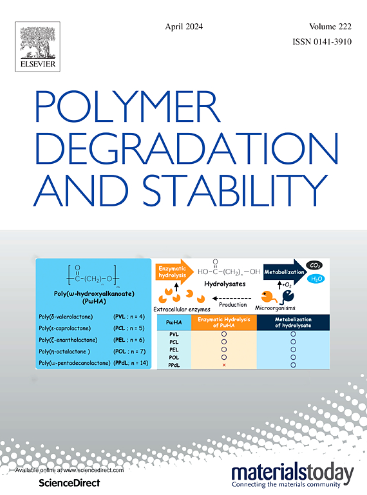An insight into the effects of the low oxidation states of phosphorous on the combustion behavior of intrinsically flame-retardant unsaturated polyester resins
IF 6.3
2区 化学
Q1 POLYMER SCIENCE
引用次数: 0
Abstract
To mitigate the migration of flame retardants in unsaturated polyester resins (UPR), flame-retardant structures can be integrated into the molecular chain to create intrinsically flame-retardant UPR. Variations in the oxidation states of phosphorus-containing flame retardants can influence the distribution of phosphorus-containing compounds between the gas and condensed phases during combustion, thereby affecting the flame-retardant performance and mechanisms. Building on previous studies of the impact of phosphorus-containing flame retardants with high oxidation numbers on UPR's combustion behavior and flame-retardant mechanism, this research further investigated the effects of phosphorus-containing structures with -1 and +1 oxidation states on the pyrolysis, heat release, smoke emission, and char formation of intrinsically flame-retardant UPR. Two kinds of itaconic acid-based phosphorus-containing dicarboxylic acids were synthesized and incorporated into the polyester backbones of UPR. Pyrolysis and combustion tests were performed to elucidate the combustion behavior regulation mechanisms of intrinsically flame-retardant UPR with low oxidation numbers. Findings indicate that both of the phosphorus-containing dicarboxylic acids exhibit strong flame inhibition, implying a dominant gas-phase mechanism. Moreover, they effectively shorten the duration of the release of the pyrolysis gases. However, the difference in oxidation states didn't result in a huge difference in their flame inhibition, and it's the condensed phase mechanism that makes the difference in their performance. FRUP2 with stable char layers demonstrates better flame retardancy. This study offers practical and efficient guidance for designing intrinsically flame-retardant UPR with high performance by elucidating the structure-performance relationship of phosphorus-containing compounds with low oxidation numbers.
为减轻阻燃剂在不饱和聚酯树脂(UPR)中的迁移,可将阻燃剂结构集成到分子链中,以制造本质上阻燃的 UPR。含磷阻燃剂氧化态的变化会影响燃烧过程中含磷化合物在气相和凝结相之间的分布,从而影响阻燃性能和机理。本研究在以往研究高氧化数含磷阻燃剂对 UPR 燃烧行为和阻燃机理影响的基础上,进一步研究了-1 和 +1 氧化态含磷结构对本质阻燃型 UPR 的热解、放热、发烟和成炭的影响。合成了两种以衣康酸为基础的含磷二羧酸,并将其加入到 UPR 的聚酯骨架中。通过热分解和燃烧试验,阐明了低氧化数本质阻燃 UPR 的燃烧行为调节机制。研究结果表明,这两种含磷二羧酸都具有很强的火焰抑制作用,这意味着它们的气相机制占主导地位。此外,它们还能有效缩短热解气体的释放时间。然而,氧化态的不同并没有导致它们在火焰抑制方面的巨大差异,凝结相机制才是它们的性能差异所在。具有稳定炭层的 FRUP2 具有更好的阻燃性。这项研究通过阐明低氧化数含磷化合物的结构性能关系,为设计具有高性能的本征阻燃 UPR 提供了实用、高效的指导。
本文章由计算机程序翻译,如有差异,请以英文原文为准。
求助全文
约1分钟内获得全文
求助全文
来源期刊

Polymer Degradation and Stability
化学-高分子科学
CiteScore
10.10
自引率
10.20%
发文量
325
审稿时长
23 days
期刊介绍:
Polymer Degradation and Stability deals with the degradation reactions and their control which are a major preoccupation of practitioners of the many and diverse aspects of modern polymer technology.
Deteriorative reactions occur during processing, when polymers are subjected to heat, oxygen and mechanical stress, and during the useful life of the materials when oxygen and sunlight are the most important degradative agencies. In more specialised applications, degradation may be induced by high energy radiation, ozone, atmospheric pollutants, mechanical stress, biological action, hydrolysis and many other influences. The mechanisms of these reactions and stabilisation processes must be understood if the technology and application of polymers are to continue to advance. The reporting of investigations of this kind is therefore a major function of this journal.
However there are also new developments in polymer technology in which degradation processes find positive applications. For example, photodegradable plastics are now available, the recycling of polymeric products will become increasingly important, degradation and combustion studies are involved in the definition of the fire hazards which are associated with polymeric materials and the microelectronics industry is vitally dependent upon polymer degradation in the manufacture of its circuitry. Polymer properties may also be improved by processes like curing and grafting, the chemistry of which can be closely related to that which causes physical deterioration in other circumstances.
 求助内容:
求助内容: 应助结果提醒方式:
应助结果提醒方式:


